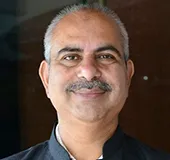
As the countdown for another round of general elections in 2019 begins, it is worth remembering a man, who was India’s first chief election commissioner and conducted the first general elections of Independent India in 1951-52. It was Sukumar Sen, an Indian Civil Services (ICS) officer.
Born in 1899, Sen had joined the ICS in 1921, served as a judge before becoming the chief secretary of Bengal during 1947-1950. In March 1950, he was chosen as the first Election Commissioner of independent India. His biggest challenge in 1951 was to involve women in the mammoth poll exercise of the first general elections on the basis of universal adult franchise. When electoral rolls were getting prepared, Sen and his team discovered that a large number of women voters who were enrolled did not have their own names but by the description of the relationship they bore to their male relations (for example A's mother, B's wife or C’s daughter). This was due to the local customs in many north and central Indian States -- of women not disclosing their names to any outsider. Sen quickly sent instructions across the country to enumerators to insist upon inclusion of the proper name of an elector in the electoral rolls. Directions were also issued to the effect that any woman who refused to give her proper name should not be registered as a voter and if she had already been registered without the name, the entry should be deleted. The unfortunate part of this diktat was that out of a total of nearly 80 million women voters in the country, nearly 2.8 million eventually failed to disclose their proper names and missed the change to cast their vote. Women from Bihar, Uttar Pradesh, Madhya Pradesh and Rajasthan were the biggest losers.
On a practical front, house-to-house survey across the length and breadth of the country had to be conducted to register every single voter. Since over 70 per cent of the voters could not read or write, the candidates were to be identified by symbols that were assigned to each major party and independent candidates, painted on the ballot-boxes (this was later changed to symbols on the ballot papers). The voters were to place the ballot papers in the box assigned to a particular candidate, and ballot was secret. There were over 224,000 polling booths, one for almost every 1000 voters. Nearly 620,000,000 ballot papers were printed. About a million officials supervised the first general elections that were held over a four-month period spread from October 25, 1951 to March 27, 1952. 173 million voters, both men and women, mostly poor and illiterate, exercising universal adult franchise was a unique experiment in the world. The voter turnout for the elections was 45.7 per cent. There were 1874 candidates belonging to 53 political parties in the fray. 56,000 presiding officers supervised these 2,24,000 polling stations across India. As many as 16,500 clerks were appointed on contractual basis to collate and type electoral rolls in their constituencies.
The first Indian general election drew huge interest abroad. Several countries, including Nepal and Indonesia, sent their official teams to witness Indian electoral exercise. Sudan, which went to polls in 1953, sought Sen’s services to conduct its general elections on universal adult franchise basis.
Author and historian Ramachandra Guha has aptly described Sen as ‘the man who had to make the election possible, a man who is an unsung hero of Indian democracy. It is a pity we know so little about Sukumar Sen. He left no memoirs and, it appears, no papers either’. According to journalist-author Vikas Lather, a road in Burdwan district of Bengal is named after Sen. Sen, Lather says, was a thinker too who had argued that republican forms of government existed in many parts of ancient India.
There were others who had ably assisted Sen. Young Pirojshah Godrej, an industrialist, contributed immensely, producing over 21 million steel ballot-boxes, one box for every candidate. Godrej had leased a village at Vikhroli in Bombay suburban area, comprising a roofed area of 2,33,000 sq ft for making these ballot boxes. The factory had to churn out more than 15,000 ballot boxes a day.
The polling process in India has undergone a spectacular change since the first election when there were as many boxes in every polling booth as there were candidates. Printed papers showing the names of candidates with their parties and symbols were pasted or hand-painted on the boxes and the voter simply put the ballot paper in the box assigned to the candidate of his/her choice. This practice was also followed in the second General Election in 1957. The marking system on the ballot papers was introduced for the third General Election for the Lok Sabha in 1962. One box for all replaced multiple boxes where a voter, after receiving the ballot paper from the presiding officer of the polling booth, would move to a corner cordoned for the purpose where he would find on a table a stamp with ‘x’ mark and a stamp pad. After marking the stamp against the name of the candidate of his choice, the voter would put the ballot paper in the box. The practice of using indelible ink on the voter’s finger as a precautionary step to prevent impersonation was introduced from the first General Election in 1952.
In a multi-religious, caste ridden, illiterate and backward society, there was no dearth of those skeptical about the electorates’ ability to respond in a politically mature manner. Western media had described India’s first elections as 'a leap in the dark,' 'fantastic' and as 'an act of faith.'
During the British era, the elections of 1937, 1942 and 1946 were held on restrictive franchise on the ground of qualifications based on property, payment of taxes etc. The Indian National Congress, which was fighting for the country’s freedom, has made it clear way back in 1928 that universal adult franchise was the goal that should ultimately be laid down for the country. A committee headed by Pandit Motilal Nehru, that had formulated the principles of a Constitution for India, had recommended the adoption of adult suffrage, after a careful consideration of the various arguments for and against it.
There were two main arguments levelled against adult suffrage. First was relating to the magnitude of the task involved. It was argued that the number of voters under adult suffrage would exceed all reasonable bounds and its adoption would be too stupendous an administrative task for the new government. The second argument of adult suffrage opponents related to the illiteracy of the voters. There were fears that 70 per cent illiteracy level prevailing in the country would render an election a farce unless an electoral system could be devised under which even an illiterate voter could cast his vote intelligently and in secret.
The Constituent Assembly of India, which prepared the Constitution, had intensely debated the issue of universal adult franchise. The Constituent Assembly unhesitatingly adopted the principle of adult suffrage with the full knowledge of the difficulties involved. According to Sen, who supervised the first general elections of the Lok Sabha and 18 State Assemblies, granting votes to one and all was an act of faith, “faith in the common man of India and in his practical common sense. This decision launched a great and fateful experiment unique in the world in its stupendousness and complexities,” Sen wrote in an extensive report on the first general elections.
By the time 1951-52 polls were held, a new Constitution of India was in place. The Constitution made a provision for an independent Election Commission. By independent, it was implied that the poll body would be free from the executive or the parliament or the party in power.
In all, candidates of over 14 national and 63 regional or local parties and a large number of independents contested the 489 seats for the Lok Sabha and 3,283 seats for the State Assemblies. Of these, 98 seats for the former and 669 for the latter were reserved for the Scheduled Castes and the Scheduled Tribes. Nearly 17,500 candidates in all stood for the seats to the Lok Sabha and the State legislatures. Interestingly, over 3000 theatres across the country had volunteered to play a documentary on the franchise, its functions and the duties of the electorate.
The views expressed above belong to the author(s). ORF research and analyses now available on Telegram! Click here to access our curated content — blogs, longforms and interviews.




 PREV
PREV


